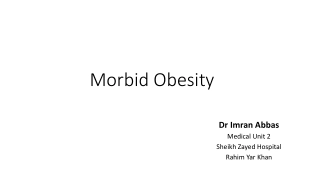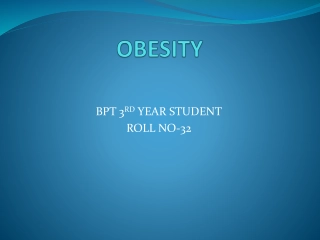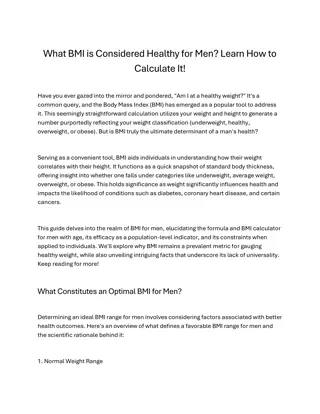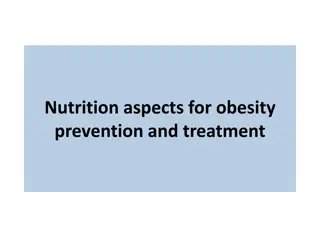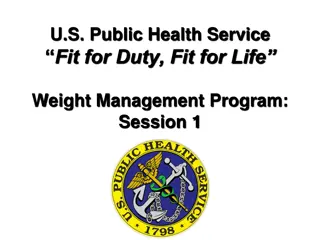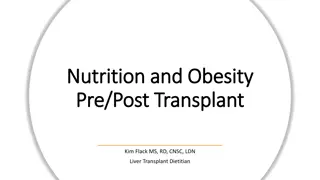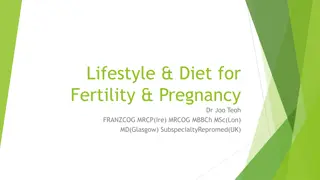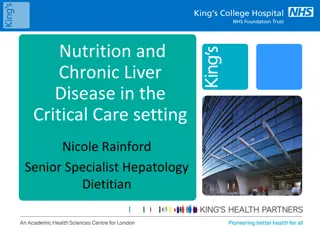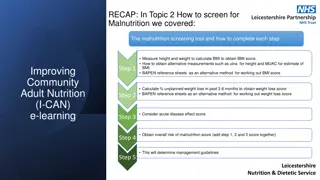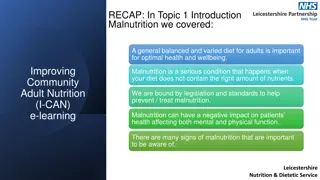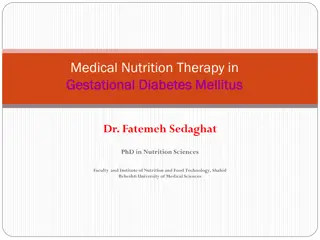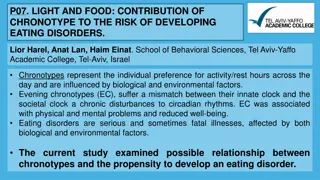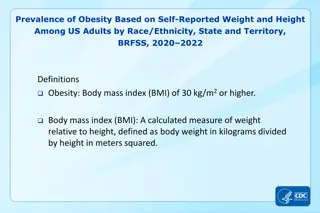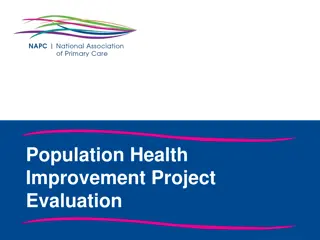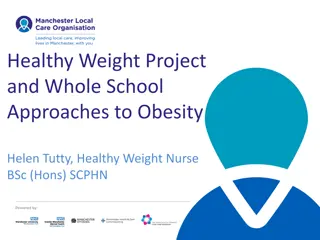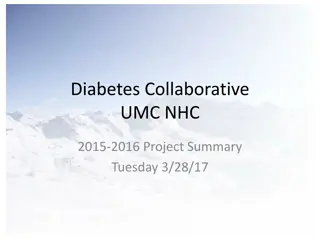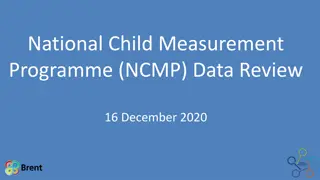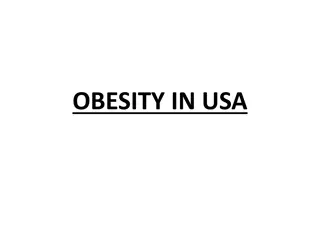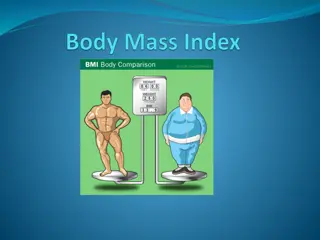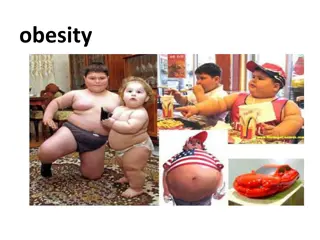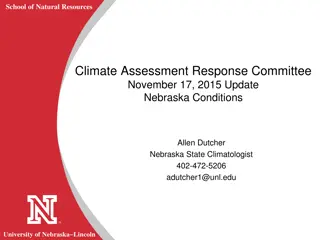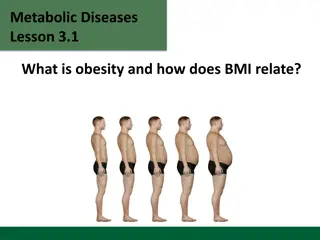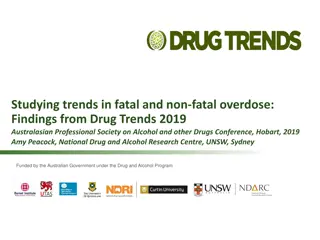Morbid Obesity
Morbid obesity, its definition, BMI, and the pathological consequences it has on health. Dr. Imran Abbas's medical unit at Sheikh Zayed Hospital in Rahim Yar Khan specializes in treating morbid obesity and related health conditions.
0 views • 24 slides
Obesity
Obesity, its causes, and how it affects overall health. Discover the role of factors such as genetics, lifestyle, and eating habits. Explore the prevalence of obesity worldwide and its correlation with various diseases. Understand the measurement of obesity through BMI and its different categories.
2 views • 19 slides
Nutritional Care Planning for Malnutrition Screening
Learn how to screen for malnutrition using tools like BMI calculation and weight loss assessment. Understand the steps to create a nutritional care plan based on MUST scores, including setting aims, implementing agreed plans, and monitoring progress. Gain insights into managing malnutrition risks an
1 views • 12 slides
Children's and Mothers' Health Trends in Northern Ireland 2021/22
Children's health in Northern Ireland showed various trends in 2021/22, including a high rate of infants born by Caesarean section, percentages of pre-term births, multiple births, infants breastfed, low and high birth weights, and overweight and obese children. Mothers' summary in 2020/21 indicated
1 views • 23 slides
Screening for Malnutrition with MUST Tool
Understanding malnutrition is crucial for maintaining optimal health. Screening with the Malnutrition Universal Screening Tool (MUST) is essential to identify individuals at risk. This tool involves assessing BMI, calculating weight loss scores, and determining overall malnutrition risk. Proper scre
5 views • 25 slides
Unlocking the Ideal Body Weight Index: Essential Factors and Strategies
Body Mass Index (BMI) and waist circumference serve as primary indicators to assess weight status in relation to potential health risks. Nevertheless, it's essential to note that these tools are not diagnostic for identifying disease risks. Comprehensive health evaluations by trained healthcare prof
4 views • 3 slides
What BMI is Considered Healthy for Men? Learn How to Calculate It!
Have you ever gazed into the mirror and pondered, \"Am I at a healthy weight?\" It's a common query, and the Body Mass Index (BMI) has emerged as a popular tool to address it. This seemingly straightforward calculation utilizes your weight and height to generate a number purportedly reflecting your
3 views • 5 slides
Nutrition Aspects for Obesity Prevention and Treatment
Obesity is defined by abnormal fat accumulation, often measured by BMI. Nutrition aspects focus on AMDR for macronutrients like carbohydrates, proteins, and fats to reduce chronic disease risks. Understanding nutrient energy values is crucial for designing effective diet programs, including ketogeni
0 views • 22 slides
U.S. Public Health Service Weight Management Program Overview
This weight management program, developed by dietitians/nutritionists in the U.S. Public Health Service, offers guidance on healthy weight loss and maintenance for service members. The program covers topics such as BMI calculation, goal setting, healthy eating habits, physical activity recommendatio
1 views • 33 slides
Nutrition and Obesity in Pre/Post-Transplant Care by Kim Flack MS, RD, CNSC, LDN
This educational material highlights the crucial role of nutrition in the pre/post-transplant phases, focusing on the evaluation, challenges, and strategies for optimizing nutrition before and after liver transplantation. It addresses the limitations of BMI in assessing nutritional status, the preva
2 views • 17 slides
Lifestyle and Diet Influence on Fertility and Pregnancy by Dr. Joo Teoh
Dr. Joo Teoh's research covers the impact of lifestyle and diet on fertility and pregnancy. It discusses the effects of age, BMI, smoking, alcohol, and weight loss interventions on reproductive health. The findings emphasize the importance of maintaining a healthy lifestyle for optimal fertility and
0 views • 19 slides
Upland Cotton Quality Trends and Analysis 2022-23
Explore the latest trends in U.S. upland cotton quality for the 2022-23 crop, including fiber competition data, yield trends, micronaire distribution, average micronaire values, regional comparisons, strength trends, and distribution. Gain insights into micronaire levels, yield trends, and strength
0 views • 30 slides
Nutritional Considerations for Chronic Liver Disease in Critical Care
Malnutrition is common in chronic liver disease, leading to complications such as ascites and infections. Sarcopenia and weight loss are prevalent regardless of BMI. Critical care patients with liver disease face challenges due to limited physiological reserve, with main causes for ICU admission bei
1 views • 17 slides
Understanding Malnutrition Screening and Nutritional Care Planning
In this overview, discover the process of screening for malnutrition, including calculating BMI, assessing weight loss, and determining overall malnutrition risk. Explore how to create a nutritional care plan based on the MUST score and set appropriate nutritional aims for patients.
0 views • 12 slides
Understanding Malnutrition Screening with MUST Tool
Delve into the importance of malnutrition screening with the Malnutrition Universal Screening Tool (MUST). Learn how to calculate BMI, assess weight loss, and determine overall malnutrition risk. Discover the key steps involved in using the MUST tool for effective patient care and management.
1 views • 25 slides
Priorities and Quality Measures for Type 2 Diabetes Care in NHS GGC
Dr. Kashif Ali leads primary care for Type 2 diabetes, while Dr. James Boyle oversees secondary care in NHS GGC. The data from December 2018 shows the number of Type 2 diabetes patients, their care processes, HbA1c levels, and BMI status. The Diabetes Quality Improvement and Outcome Measures aim to
0 views • 27 slides
Comprehensive Overview of Obesity Management and Treatment Options
Obesity is a prevalent and severe health issue impacting both adults and children. This article delves into the prevalence of obesity, factors influencing it, and classification based on BMI. It also explores the impact of genetics, environment, behaviors, and other factors on weight gain. Additiona
1 views • 29 slides
Gestational Diabetes Mellitus: Overview and Risk Factors
Gestational Diabetes Mellitus (GDM) is defined as any level of glucose intolerance first detected during pregnancy, affecting approximately 7% of pregnancies globally. In Iran, GDM prevalence varies between 1.3% to 10%. Factors like age, BMI, weight gain, and family history influence GDM development
8 views • 50 slides
Impact of COVID-19 on Gen-Z Health: A Retrospective Study
The CHANGE.UP Project conducted a retrospective study to analyze the effects of the COVID-19 pandemic on the health of Generation Z individuals. The study examined physical, mental, and social impacts, revealing insights into different health dimensions and their interconnections. Results highlighte
0 views • 11 slides
Understanding Anorexia Nervosa: Symptoms and Psychopathology
Anorexia nervosa is a serious eating disorder characterized by food restriction, bingeing, purging, and distorted body image. Common symptoms include excessive exercise, body checking, and rigid food rules. Psychopathology aspects include intrusive dread of fatness, self-imposed low weight threshold
0 views • 42 slides
Proper Techniques for Weighing and Measuring Children in CHDP Well-Child Exams
This article provides guidance on accurate weighing and measuring of children during CHDP well-child exams. It covers the importance of measurements, accurate techniques, interpreting BMI data, guiding providers for further assessments, and respecting privacy. Learn to manage challenges and ensure a
0 views • 30 slides
Impact of Chronotype on Developing Eating Disorders
Chronotypes, representing individuals' morningness-eveningness preference, play a significant role in the propensity to develop eating disorders. Evening chronotypes, facing a mismatch between their internal clock and societal demands, have been linked to various health and mental health issues. A s
0 views • 5 slides
Associations Between Wyoming Third Grade Body Mass Index and School Food Environment
Senate File 93 in Wyoming authorized the state's first Oral Health Initiative in 2009, focusing on measuring Body Mass Index (BMI) of third graders. The study aims to evaluate how individual and school factors influence the likelihood of children being overweight or obese. It hypothesizes that schoo
0 views • 23 slides
Prevalence of Obesity Among US Adults by Race/Ethnicity, State, and Territory 2020-2022
The prevalence of obesity among US adults was studied based on self-reported weight and height by race/ethnicity, state, and territory using data collected through the Behavioral Risk Factor Surveillance System (BRFSS) in 2020-2022. The definition of obesity was a body mass index (BMI) of 30 kg/m2 o
0 views • 18 slides
Population Health Improvement Project Evaluation - Impact and ROI Analysis
The evaluation of a Population Health Improvement Project focused on identifying and supporting individuals with mild or moderate frailty, anxiety, and high BMI to reduce GP demand. The intervention, led by a Social Prescribing and Care Coordination team, aimed to improve patient activation, wellbei
0 views • 11 slides
Improving Nutrition Goals for Children with CF
Optimizing growth and weight gain is crucial for children with cystic fibrosis (CF) to enhance health outcomes and survival. Behavioral barriers often hinder patients from achieving nutrition goals, but interventions combining nutrition and behavioral strategies have shown effectiveness. This approa
0 views • 27 slides
Powercor Industry Forum Audit Results and Trends Analysis
Audit results and trends analysis reveal that there were 256 audits completed, with 50 being re-audits. Additional resources were acquired to meet industry demand, but audit volumes in Q4 did not meet forecast. Turnaround times improved with the deployment of more auditor resources. Trends show issu
0 views • 8 slides
Understanding Obesity Hypoventilation Syndrome: Diagnosis and Mechanisms
Obesity Hypoventilation Syndrome (OHS) is a condition characterized by hypoventilation during sleep due to obesity-related changes in the respiratory system. Diagnosis requires a high index of suspicion and involves criteria such as BMI>30, daytime hypercapnia, and sleep-disordered breathing. The pa
0 views • 21 slides
Healthy Weight Project and Whole School Approaches to Obesity by Helen Tutty, Healthy Weight Nurse
Helen Tutty, a Healthy Weight Nurse, leads a project in Manchester targeting severely obese primary school children. The project involves early intervention, providing support to families, and aims to reduce BMI over 12 months. Positive outcomes include high engagement rates and clinically significa
0 views • 10 slides
Diabetes Collaborative Project 2015-2016 Summary
In the Diabetes Collaborative Project 2015-2016, a random sample of 75 diabetic patients' records were queried monthly at each clinic site, with a total sample size of 450 patients reviewed monthly. Outreach activities were conducted based on sample data results. Metric goal variations were observed
0 views • 7 slides
Challenges and Trends in India's Health Insurance Industry
The Health Insurance Regulatory and Development Authority of India faces various challenges and trends within the health insurance industry. The content discusses issues such as trends in health insurance premiums, stakeholder involvement, policyholder protection, and perspectives from insurers and
0 views • 22 slides
National Child Measurement Programme (NCMP) Data Review
The National Child Measurement Programme (NCMP) in England measures the height and weight of over a million children aged 4-5 and 10-11 each year. This review focuses on NCMP data sets from 2017/18 to 2019/20 for Borough of Brent. The analysis includes BMI trends, gender distribution, and ethnicity
0 views • 29 slides
Obesity Epidemic in the USA and Global Trends
The USA faces one of the highest obesity rates globally, with two out of every three Americans considered overweight or obese. Obesity is classified based on BMI, and rates have been on the rise in OECD countries. However, recent data shows a slower pace of increase in some countries. Child obesity
0 views • 10 slides
Unveiling the Controversy Surrounding BMI and Its Historical Evolution
The body mass index (BMI) is a widely used measurement to determine healthy body weight based on height and weight. However, it does not directly measure body fat percentage, sparking controversy. Discover the origins of BMI from Adolphe Quetelet to Ancel Keys, its categories, and how it evolved to
0 views • 15 slides
Childhood Obesity: Causes, Effects, and Management
Childhood obesity is a growing concern affecting children globally. Factors such as genetics, environment, metabolism, lifestyle, and eating habits contribute to its development. The condition poses serious health risks and can lead to various diseases. Diagnosis is based on the Body Mass Index (BMI
0 views • 20 slides
Understanding Obesity: Definition, Causes, and Prevention
Obesity is characterized by abnormal or excessive fat accumulation, posing health risks. It is measured using Body Mass Index (BMI) and is classified based on BMI ranges. The prevalence, causes, prevention strategies, and classification criteria for obesity are essential in addressing this global he
0 views • 23 slides
Climate Assessment Update: Nebraska Precipitation Trends and Impacts
Nebraska's recent climate assessment reveals varying precipitation trends across different regions. Positive short-term trends in the western part of the state indicate soil moisture recharge, while negative trends in south-central and southeast Nebraska pose challenges. A persisting dry signal for
0 views • 13 slides
Understanding Obesity: BMI and Its Health Implications
Obesity is a widespread health concern with various chronic conditions associated with it. This lesson delves into the definition of obesity, the role of BMI, and the health risks linked to excess body fat. It covers the rising rates of overweight and obesity in the US, the impact on different organ
0 views • 26 slides
Trends in Fatal and Non-Fatal Overdose: Drug Trends 2019 Conference Findings
Studying trends in fatal and non-fatal overdose at the Australasian Professional Society on Alcohol and other Drugs Conference in 2019, Amy Peacock presented findings funded by the Australian Government. The research involved analyzing data sources like cryptomarket data, mortality data, hospitaliza
0 views • 13 slides
Recent Research on Food Environments in New York City
Exploring the impact of food environments on BMI among respondents to the NYC Community Health Survey, this research delves into neighborhood effects on diet, physical activity, and BMI. Analyses adjust for various factors, and the association between BMI and BMI-unhealthy outlets is examined in rel
0 views • 7 slides
